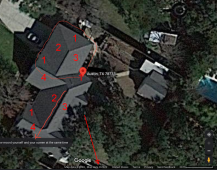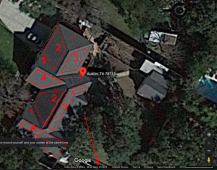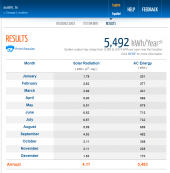Just when you thought it would be safe to open a noob's solar plans.....
I am trying to put a solar system on my elderly parents home so they can have some relief from their power bills and some emergency backup for medical devices etc. I have been studying and planning for a few months (which has been like drinking out of a fire hose, but at least the water is tasty.....
I decided to work with Signature Solar since they are fairly close to home and I like that they have in-house warranty/repair etc.
My situation is somewhat challenging because we can only put panels on their garage which is not shaded by trees, but the roof planes point to the least favorable areas of the sky. (N,E.W) so I am trying to go with the highest wattage panel to provide the best energy producing/charging capacity.
The original plan was to do 32 panels (4 strings of 8) but the designer I have been working with has provided me with a wiring diagram that is somewhat confusing and uses 6 strings . I was also a little taken back that they weren't familiar with a pass through for a shingle roof into the attic, so I though I would reach out to this great group for some ideas before I pulled the trigger on this massive MASSIVE and multi-faceted project.
While I am familiar with general construction, I have always let others handle the electrical, even though I've learned a lot lately. Any advice or tips as far as string arrangement, junction box placement would be greatly appreciated. I will try to include all relative photos as well. Thank you for your time and consideration.
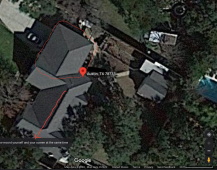
Roof pic^^^^^ The PV wire will pass through into the attic and travel to the opposite end of the house where we will be extending a room to house a "power shed" w/ batteries etc. 60KW of battery (2 racks of 6) and 4 inverters
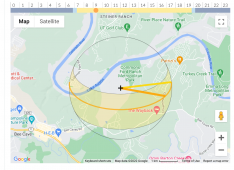
Sun path relative to my general location.

82.44 x 40.86 x 1.37" actual panel size
My panel drawing. (The panels are a little larger on graph paper than their actual size)
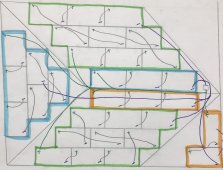
Wiring diagram I received from the designer. ?????????????????!!!!!!!!!!!
(I'm hoping that these can be consolidated to 4 strings instead of six as they suggested) 1 string of 8 panels per inverter (which can handle up to 8000W of PV input each), plus hopefully easier install at the soladeck junction box.
I'm not sure if I have my junction box in the right location for this application either. I'm also not sure if 10 gauge PV wire is the right size for this. This has become a little overwhelming because I'm not sure I'm getting 100% best advice.
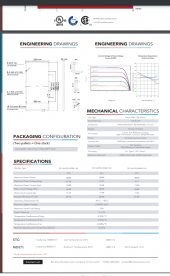
(I hope these panel specs are large enough to read)
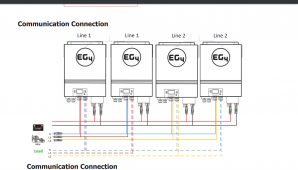
Inverter layout. This will be connected to the 12 of the same brand EG4 batteries in 2 racks

Front of garage
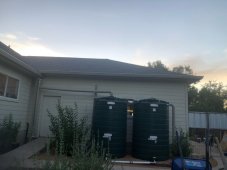
Anyway, I know this might be a bit much to dump on this community, but I really didn't know where else to turn. Again, I am deeply grateful for any advice that can be given and will be happy to answer any more questions or provide relevant info. Kindest Regards, Jefferson
I am trying to put a solar system on my elderly parents home so they can have some relief from their power bills and some emergency backup for medical devices etc. I have been studying and planning for a few months (which has been like drinking out of a fire hose, but at least the water is tasty.....
I decided to work with Signature Solar since they are fairly close to home and I like that they have in-house warranty/repair etc.
My situation is somewhat challenging because we can only put panels on their garage which is not shaded by trees, but the roof planes point to the least favorable areas of the sky. (N,E.W) so I am trying to go with the highest wattage panel to provide the best energy producing/charging capacity.
The original plan was to do 32 panels (4 strings of 8) but the designer I have been working with has provided me with a wiring diagram that is somewhat confusing and uses 6 strings . I was also a little taken back that they weren't familiar with a pass through for a shingle roof into the attic, so I though I would reach out to this great group for some ideas before I pulled the trigger on this massive MASSIVE and multi-faceted project.
While I am familiar with general construction, I have always let others handle the electrical, even though I've learned a lot lately. Any advice or tips as far as string arrangement, junction box placement would be greatly appreciated. I will try to include all relative photos as well. Thank you for your time and consideration.

Roof pic^^^^^ The PV wire will pass through into the attic and travel to the opposite end of the house where we will be extending a room to house a "power shed" w/ batteries etc. 60KW of battery (2 racks of 6) and 4 inverters

Sun path relative to my general location.

82.44 x 40.86 x 1.37" actual panel size
My panel drawing. (The panels are a little larger on graph paper than their actual size)

Wiring diagram I received from the designer. ?????????????????!!!!!!!!!!!
(I'm hoping that these can be consolidated to 4 strings instead of six as they suggested) 1 string of 8 panels per inverter (which can handle up to 8000W of PV input each), plus hopefully easier install at the soladeck junction box.
I'm not sure if I have my junction box in the right location for this application either. I'm also not sure if 10 gauge PV wire is the right size for this. This has become a little overwhelming because I'm not sure I'm getting 100% best advice.

(I hope these panel specs are large enough to read)

Inverter layout. This will be connected to the 12 of the same brand EG4 batteries in 2 racks

Front of garage

Anyway, I know this might be a bit much to dump on this community, but I really didn't know where else to turn. Again, I am deeply grateful for any advice that can be given and will be happy to answer any more questions or provide relevant info. Kindest Regards, Jefferson



